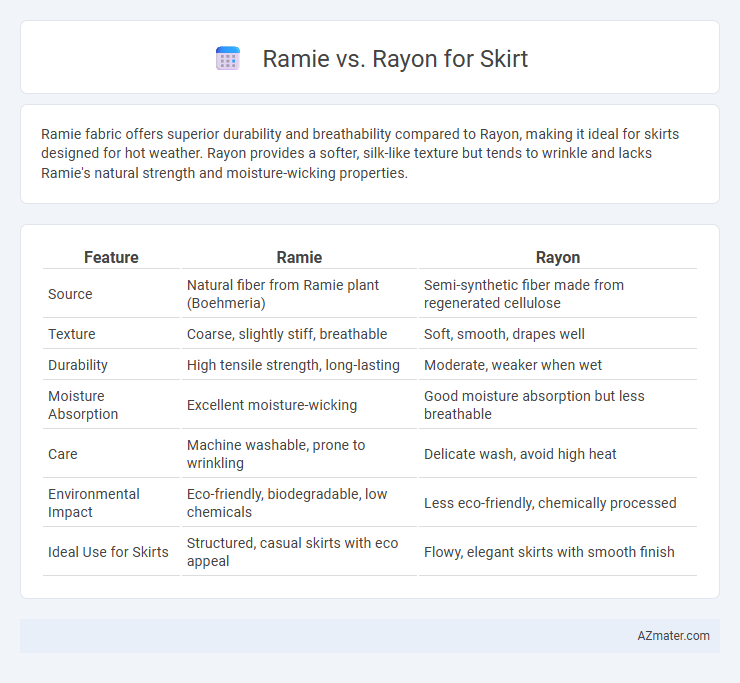Ramie fabric offers superior durability and breathability compared to Rayon, making it ideal for skirts designed for hot weather. Rayon provides a softer, silk-like texture but tends to wrinkle and lacks Ramie's natural strength and moisture-wicking properties.
Table of Comparison
| Feature | Ramie | Rayon |
|---|---|---|
| Source | Natural fiber from Ramie plant (Boehmeria) | Semi-synthetic fiber made from regenerated cellulose |
| Texture | Coarse, slightly stiff, breathable | Soft, smooth, drapes well |
| Durability | High tensile strength, long-lasting | Moderate, weaker when wet |
| Moisture Absorption | Excellent moisture-wicking | Good moisture absorption but less breathable |
| Care | Machine washable, prone to wrinkling | Delicate wash, avoid high heat |
| Environmental Impact | Eco-friendly, biodegradable, low chemicals | Less eco-friendly, chemically processed |
| Ideal Use for Skirts | Structured, casual skirts with eco appeal | Flowy, elegant skirts with smooth finish |
Introduction to Ramie and Rayon Fabrics
Ramie is a natural fiber derived from the stalks of the Chinese nettle plant, known for its strength, breathability, and lustrous appearance, making it a durable and eco-friendly choice for skirts. Rayon, a semi-synthetic fiber produced from cellulose pulp, offers a soft, smooth texture with excellent drape and vibrant dye absorption, ideal for lightweight, flowy skirt designs. Both materials provide unique benefits in skirt fabrication, with ramie excelling in durability and sustainability, while rayon stands out for comfort and versatility in fashion.
Origin and Production Processes
Ramie, a natural fiber derived from the stalks of the Chinese nettle plant, undergoes a labor-intensive process involving harvesting, retting, and degumming to extract the long, lustrous fibers ideal for skirts with a crisp texture. Rayon, a semi-synthetic fiber made from cellulose sourced primarily from wood pulp, is produced through a chemical-intensive method called viscose processing, which converts natural cellulose into a versatile, soft fabric frequently used in skirt manufacturing. The distinct origins--ramie's plant-based bast fiber versus rayon's regenerated cellulose--and their divergent production techniques significantly impact the texture, breathability, and environmental footprint of skirts made from these materials.
Appearance and Texture Comparison
Ramie fabric for skirts boasts a natural lustrous sheen with a slightly coarse texture that provides a crisp, structured appearance ideal for formal wear. Rayon offers a silky, smooth surface with excellent drape, yielding a soft and flowy look perfect for casual or elegant styles. While ramie retains shape and breathability due to its natural fiber, rayon's synthetic origin allows for vibrant colors and a more delicate feel against the skin.
Durability and Longevity
Ramie offers superior durability compared to rayon, as its natural fibers are strong and resistant to wear and tear, making skirts made from ramie longer-lasting. Rayon, while soft and comfortable, tends to weaken when exposed to moisture and frequent washing, reducing the lifespan of skirts. For longevity, ramie skirts maintain their shape and texture over time, whereas rayon skirts may experience pilling and fading more quickly.
Comfort and Breathability
Ramie fabric offers exceptional breathability due to its natural fibers, making skirts comfortable and cool in warm weather. Rayon, while soft and smooth, tends to retain moisture and can feel less breathable compared to ramie. Choosing ramie for skirts enhances ventilation and comfort, especially in hot and humid conditions.
Eco-Friendliness and Sustainability
Ramie, a natural fiber derived from the stalks of the Chinese nettle plant, offers superior eco-friendliness compared to rayon due to its biodegradable properties and minimal chemical processing requirements. Rayon, a semi-synthetic fiber made from regenerated cellulose, involves intensive chemical treatments that raise environmental concerns despite its biodegradable nature. When choosing sustainable fabrics for skirts, ramie's renewable cultivation and lower environmental impact make it a more responsible option over rayon.
Care and Maintenance Requirements
Ramie fabric, derived from the nettle plant, requires gentle hand washing or delicate machine cycles with mild detergent to maintain its natural luster and prevent fiber weakening. Rayon skirts demand extra care by avoiding high heat during washing or drying, preferably requiring cold water hand washing or dry cleaning to prevent shrinking and fabric distortion. Both materials should be air-dried flat or hung in shade to preserve shape and texture, with ramie benefiting from occasional ironing at low temperature to smooth wrinkles.
Color Retention and Dye Affinity
Ramie fibers exhibit excellent dye affinity, allowing vibrant and long-lasting color retention in skirts due to their high moisture absorbency and crystalline structure. Rayon also offers good color retention but tends to fade faster over time because of its semi-synthetic cellulose composition, which is less resistant to sunlight and washing. Choosing ramie ensures skirts maintain richer colors and durability, especially for garments frequently exposed to washing and sunlight.
Cost and Accessibility
Ramie fabric tends to be more affordable and widely accessible due to its natural fiber origins and simpler processing compared to rayon, which is a semi-synthetic fiber requiring more complex manufacturing. Rayon skirts often incur higher costs reflecting the intricate production process and limited eco-friendly sourcing options. Consumers seeking budget-friendly and readily available skirt materials typically favor ramie over rayon for cost-effectiveness and ease of purchase.
Best Choice for Skirt Design
Ramie fabric, prized for its durability and natural luster, offers a breathable and eco-friendly choice ideal for lightweight, structured skirts with a crisp appearance. Rayon, a semi-synthetic fiber derived from cellulose, provides superior drape and softness, making it perfect for flowy, elegant skirt designs that require fluid movement. For skirt design, ramie suits casual, sturdy styles while rayon excels in producing comfortable, stylish skirts with vibrant colors and smooth textures.

Infographic: Ramie vs Rayon for Skirt
 azmater.com
azmater.com